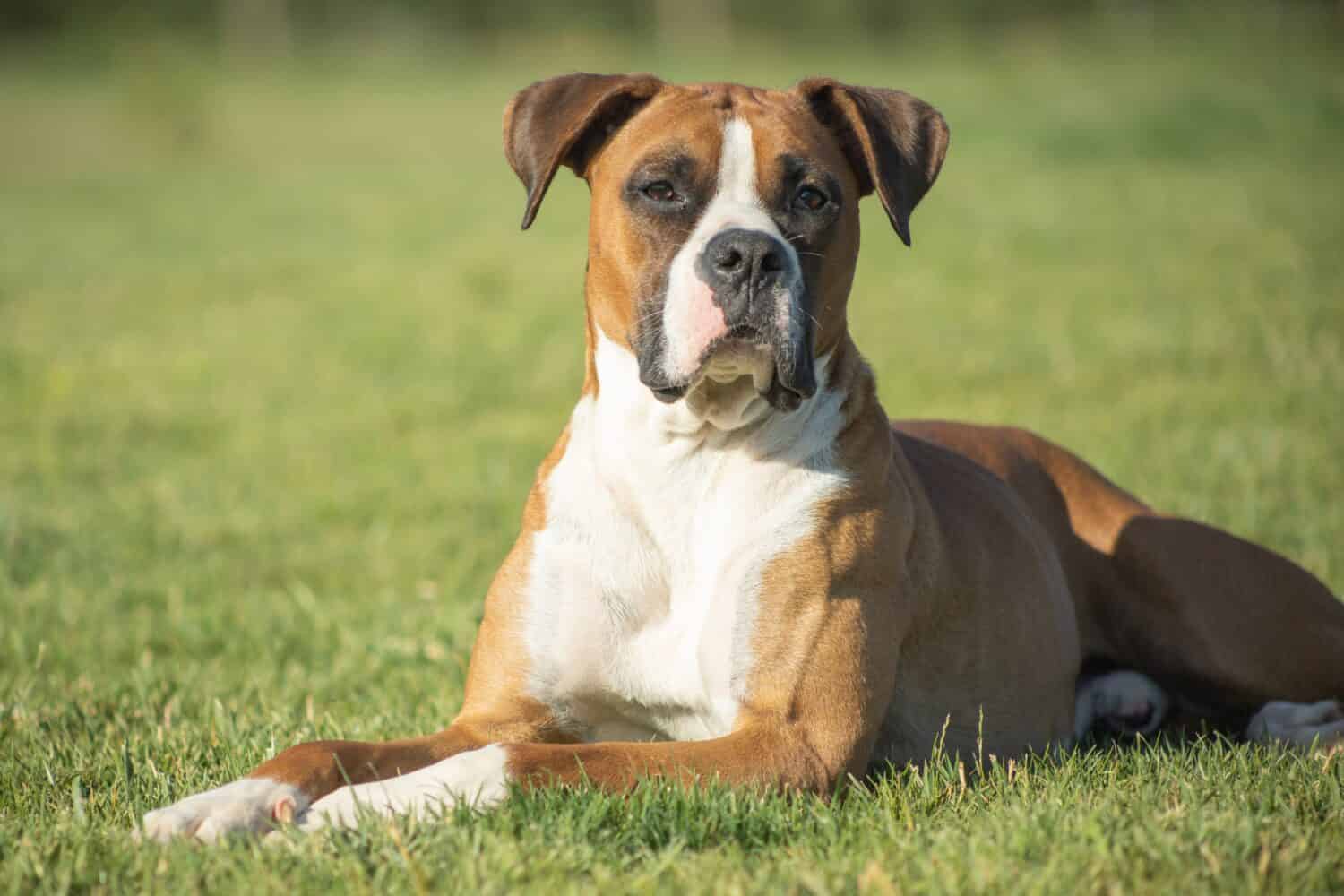There are more than 360 official dog breeds in the world, so choosing the breed that is perfect for you and your family is beyond difficult. If large friendly dogs are your thing, then two of your best options are Labrador retrievers and boxers. These dog breeds have different traits, but they are both excellent choices for most families.
In one corner, we have the Labrador retriever, a bundle of energy who adores water. And in the opposite corner, we have the boxer, a muscular and playful breed.
From their appearance and personalities to their trainability and exercise needs, we’re about to dive deep into the key differences that set these remarkable dogs apart.
Labrador Retriever

Labrador retrievers are the most popular dog breed in the United States.
©sanjagrujic/Shutterstock.com
With their sweet faces and lovable nature, Labrador retrievers have captured the hearts of dog lovers all across the country. Labs make fantastic family companions and are perfect for those looking for a medium or large-sized dog.
What sets Labs apart is their friendly and outgoing personality. They are known for their high spirits and an abundance of affection. So, it’s no wonder why they are so popular among families seeking a furry friend.
The Labrador retriever proudly holds the number one spot in registrations with the American Kennel Club. Their warm and intelligent nature is what attracts both dog enthusiasts and those who may not have much experience taking care of a canine.
As of 2022, Labs have held the title of being the most popular registered dog breed in the US for an incredible 31 years in a row! This speaks volumes about their enduring appeal and the undeniable love they receive from people all over the nation.
There are over 100,000 Labrador retrievers in the United States, according to estimates from 2022!
Boxer

Boxers are loyal and affectionate companions that can also act as guard dogs.
©ibanezfilm/Shutterstock.com
Just like Labs, boxers are a remarkable breed known for their loyalty, charisma, and intelligence. They hold a significant place in the American Kennel Club’s breed recognition and are currently ranked as the tenth most popular breed.
With a history as working dogs, boxers have a notable reputation. They were among the first breeds to serve as police dogs and are also popular guide dogs. While they excel in these roles, boxers are also loving companions and guard dogs, making them particularly well-suited as loyal family pets, especially adoring children. They are exceptionally intelligent and loyal to their owners, who can train them to follow many commands.
Despite their roots as formidable guard dogs, one of the boxer’s most endearing qualities is their immense love for their human companions and their desire to be loved in return.
They exhibit a protective and patient nature, making them an ideal choice for families searching for a devoted and reliable canine companion.
Comparing them to Labs, boxers possess their own unique traits and charm. Both breeds share a remarkable bond with their families, bringing joy, love, and unwavering devotion to the households they become a part of.
Labrador Retriever vs. Boxer: Key Differences

Labs and boxers are two extremely popular dog breeds that are excellent choices for most owners.
©anetapics/Shutterstock.com
Let’s explore the key differences between Labrador retrievers and boxers, two beloved dog breeds with their own unique qualities.
1. Size and Weight
When comparing Labrador retrievers and boxers, there are some key differences in their height and size.
Both male and female Labrador retrievers are generally smaller in size and weight than male and female boxers. Boxers can reach a maximum height of around 25 inches tall and a weight of 80 pounds, while Labs can reach a max height of around 24.5 inches and a weight of 80 pounds. Here is a chart to further break down the sizes.
| Male Labrador | Female Labrador | Male Boxer | Female Boxer | |
|---|---|---|---|---|
| Height | 22.5 to 24.5 inches tall | 21.5 to 23.5 inches tall | 25 inches tall | 21 to 25 inches tall |
| Weight | 65 to 80 pounds | 55 to 70 pounds | 65 to 80 pounds | 50 to 65 pounds |
2. Appearance
Labrador retrievers are easily recognizable due to their drop ears, broad heads, and expressive, large eyes. One notable feature of Labs is their thick, yet relatively short, double coat. This coat is not only dense but also highly water-repellent. Another well-known trait of Labradors is their “otter tail,” which is sturdy, thick, and nearly straight off the topline. Their feet are described as “webbed,” with the skin between the toes that aids in swimming.
In terms of color, Labs can range from chocolate to black and even shades of yellow, red, or nearly white.
On the other hand, boxers have regal and distinctive square-shaped heads. They also have a blunt muzzle and an undershot jaw.
Boxers possess a robust and muscular body characterized by a broad and sturdy chest and a compact yet powerful back. Although their ears naturally fold, there has been a long-standing tradition of cropping them to give them an upright stance. However, boxer owners are doing this less frequently nowadays. These magnificent dogs also have short coats that don’t shed excessively.
Some individuals showcase a beautiful fawn hue, while others display an eye-catching brindle pattern. In most cases, their faces or masks are black, adding to their distinctive look. Additionally, many boxers have white markings on their chest, face, and paws.
3. History
The lineage of the Labrador retriever dates back to the 1830s. During this time, European settlers in Newfoundland bred St. John’s water dogs, which they had obtained from ships trading between Poole in Dorset and Canada. These dogs were then crossed with British hunting dogs, creating the Labrador retriever breed that we know today.
In contrast, boxers have a different ancestral background. They are believed to be descendants of now-extinct Bullenbeisser breeds, which were mixed with bulldogs, mastiffs, and possibly Great Danes and terriers. The breeding of boxers took place in Germany during the 19th century. Originally used for bull baiting, they later became valuable helpers for butchers, assisting in controlling cattle within slaughterhouses.
4. Temperament
Labradors are incredibly playful and kind-hearted. Thanks to their loyal and friendly nature, they have a natural affinity for children, other dogs, and even strangers. However, Labradors’ welcoming demeanor means they are not well-suited to be watchdogs, as they tend to view everyone as a potential friend.
At the same time, Labradors excel at being devoted companions, offering unconditional love and affection every moment of the day. Their intelligence and friendly disposition make them ideal candidates for roles such as therapy dogs in hospitals and assistance dogs for individuals with disabilities.
If you’re searching for a dog that possesses a multitude of qualities, boxers are the perfect choice. They are not only courageous, alert, and intelligent, but they also have an endearing and cheerful nature. Boxers are known for their playfulness and even silliness, which brings joy to their owners’ lives.
Despite their size, they are incredibly affectionate and enjoy cuddling and bonding with their family. Boxers’ loyalty and protective instincts make them excellent companions, particularly for children. Unlike Labs, their alertness, curiosity, and fearlessness further contribute to their role as exceptional guard dogs, ensuring the safety and security of their loved ones.
5. Grooming
When it comes to grooming needs, Labrador retrievers require regular brushing to keep their coat in good condition. During their heaviest shedding seasons, it may be necessary to brush them once a day. Labradors also have a tendency to get dirty, so occasional baths are recommended to keep them clean and fresh.
On the other hand, boxers are known for their low-maintenance grooming requirements. Their short coat hardly sheds, which means professional grooming is not necessary. Additionally, boxers are naturally clean dogs, so bathing is only necessary when needed. To keep a boxer looking neat, weekly brushing with a rubber curry brush is sufficient.
6. Intelligence
When comparing intelligence among dog breeds, Labrador retrievers rank impressively as the 7th smartest breed out of 138 different breeds. This places them among the most intelligent canines. Notably, Labradors exhibit exceptional retrieving instincts and possess a remarkable ability to adapt to new situations, setting them apart as highly intelligent compared to other breeds.
Boxers are not as bright as Labs and fall into the category of average intelligence when considering measures of “obedience & working intelligence.” According to the renowned canine psychologist Stanley Coren, they rank as the 90th most intelligent dog breed. Despite this ranking, boxers demonstrate intuitive learning abilities and have a knack for drawing lessons from past experiences.
7. Training
Labradors possess remarkable trainability due to their high intelligence and strong motivation. Their lively nature and quick grasp of house training make them a delightful choice, particularly for novice owners. With their playful and intelligent temperament, Labradors are ideal companions. They are easy-going pets that bring immense joy, but it’s important to note that they require additional attention and exercise to thrive due to their high energy levels.
Contrary to Labradors, training boxers can be more challenging as they are clever dogs but can also be quite stubborn. Therefore, it is crucial to employ positive, reward-based training methods from a young age for boxers. These dogs mature at a slower pace compared to other breeds, resulting in the retention of a significant amount of puppy energy in their larger bodies. This aspect can present a challenge for some owners, such as jumping and knocking over furniture with their large bodies.
If you are unable to devote time to exercise your boxer and provide mental stimulation, establishing a solid training foundation and building a strong bond with your dog may prove to be difficult.
8. Price
The average price range for Labs when purchasing from a breeder is typically between $1000 and $2000. Show-quality Labrador puppies, which have exceptional conformation and are often seen in competitions, tend to be priced towards the higher end, around $1800 to $2000. If you’re looking for a Labrador with a focus on field activities and hunting, you can expect to find puppies in the slightly lower price range of around $1500.
Keep in mind that the color of the Labrador can also impact the price, with Chocolate Labradors usually costing the most due to their relative rarity compared to black or yellow Labs. Monthly expenses for Labradors are only between $100-$200.
Compared to Labrador retrievers, boxers can be pricey. Purchasing a purebred puppy from a reputable breeder will generally cost you between $800 and $2800. The specific price can vary based on factors such as the breeder’s reputation, the puppy’s pedigree, and any additional health testing or certifications that the parents have undergone. Boxers will hit your wallet as their monthly expenses exceed Labrador’s. You can expect to pay anywhere between $290-$600.
The photo featured at the top of this post is © anetapics/Shutterstock.com
Ready to discover the top 10 cutest dog breeds in the entire world?
How about the fastest dogs, the largest dogs and those that are -- quite frankly -- just the kindest dogs on the planet? Each day, AZ Animals sends out lists just like this to our thousands of email subscribers. And the best part? It's FREE. Join today by entering your email below.
Thank you for reading! Have some feedback for us? Contact the AZ Animals editorial team.







